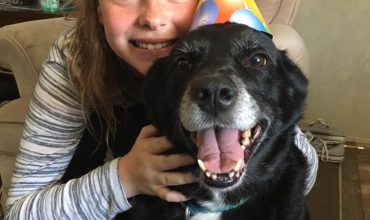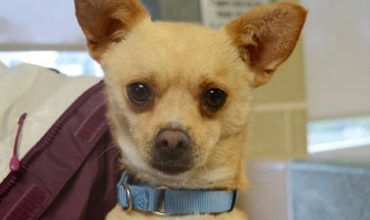Many dogs and cats get along very well, especially if they’ve grown up with each other or have prior experience living with the other species. When bringing a new dog home to meet your resident cat, or bringing a new cat into your home to meet your dog, there are a few steps you can follow to make those introductions as successful as possible. First impressions are important, so you’ll want to set up introductions carefully so that both animals feel safe and have a pleasant experience getting acquainted with one another. Good canine candidates for living with cats: Puppies
Read More
Posts by Wendy Welch
Dog-to-Dog Introductions
Adding another dog to your household can bring you and your current dog more fun and companionship. However, it is important to realize that your current dog will need time to adjust to a new sibling. In the long run, things will probably work out fabulously, but in the beginning, it is very important to take a few extra steps to make everyone is comfortable with the new arrangement. This article provides some guidelines for smooth and safe introductions to ensure that your dogs’ relationship gets off to a great start. Maximizing the potential for a great relationship between your
Read More
Bringing your new dog home
[print-me] Congratulations on your new dog! Below is some need to know information that will help you transition your new dog into your home and family. The Initial Adjustment Period The First Three Days During the first 72 hours of having your new dog home he or she will be in a heightened state of stress. This is similar to the stress a person might have from getting a new job. Though it’s good stress, it’s still very stressful and consistency, stability and predictability are key to helping your new dog feel comfortable in his new home. During this time,
Read More
Addyson: Birthday donation
Addyson donated cat food, dog bones, and dog toys for her birthday. She was inspired to donate to HSHV because her family adopted their first dog, Yukon, from HSHV. Thank you so much Addyson for your donation and for providing Yukon with such a great home!
Read More
Agility
Agility is a fun, interactive sport for dogs of all breeds/types, sizes and ages. It builds and enhances your relationship with your dog, helps both of you communicate more effectively, increases attention span, focus, confidence and attentiveness; expends mental and physical energy for your dog; and so much more– all while both you and your dog have fun learning the agility apparatus. This class is for all levels where dogs learn to gain confidence on and master the obstacles in agility such as jumps, tunnels, chutes, tippy board, tire, weave poles, etc. The equipment is adjustable to meet the needs of
Read More
Reactive Rover
Do you have a dog that is PEOPLE-FRIENDLY, but exhibits on-leash reactivity, such as barking and lunging, when he or she sees other dogs? Does your dog become stressed, uncomfortable, or over-aroused in the presence of other dogs, and do you have a hard time keeping your dog calm and focused when other dogs are around? This may be the class for you! Reactive Rover classes will help you understand your dog’s reactivity, and will give you methods for managing and modifying it. We solely use positive methods and work at each dog’s individual level, so that over time we
Read More
Basic Manners
Basic Manners teaches people how to maintain control of their dog through safe, positive, on and off leash handling. Everyone has seen the dog who behaves in their home but struggles out in the real world when they see another person, dog or squirrel. Basic class teaches handlers how to keep their dog focused and in control even the most highly distracting environments. Basic class teaches people how to motivate their dogs to be excited to work for and with them in all situations. It’s the difference between having a dog who only listens when you have a treat or force them and
Read More
Puppy Preschool
The number one most important thing for puppies is that they are socialized to as many things, places and people as possible. Once puppies reach a certain age—around 4 to 6 months—their ability to easily accept new experiences begins to wane. For this reason, we promote early and positive socialization and strive to give owners the tools to help their puppy grow into happy and well adjusted adult dogs. In puppy class, we go over the best ways to meet your puppies basic needs in a way that makes everyone happy. This class teaches how to provide outlets for normal
Read More
Upper Respiratory Infections in Cats (Cat colds!)
[print-me] Upper Respiratory Infections in cats are caused by a complex of viruses, just like the common cold in people. These airborne infections are only contagious between cats and kittens. Signs include sneezing, discharge from the eyes and/or nose, lack of appetite, fever and lethargy. Antibiotics are prescribed only when there is a secondary bacterial infection, as there is no treatment for the viral part. Some cats and kittens will stop eating when they are congested so feed fishy foods such as Fancy Feast or 9-Lives. Good nutrition is a key part of fighting the URI. If you cat refuses
Read More
Kennel Cough (Dog colds!)
[print-me] Kennel cough is a highly contagious yet common canine disease caused by a complex of viruses and the bacteria known as Bordetella. Kennel cough is irritating to dogs and to owners but it is not fatal nor is it contagious among animals other than dogs. Dogs that have been boarded, groomed, or have spent time at a shelter or a Humane Society may contract this annoying disease. Newly adopted dogs and puppies are very likely to catch it. Symptoms The main symptom is a dry, hacking cough followed by a gag. The cough sounds like your dog is trying
Read More










